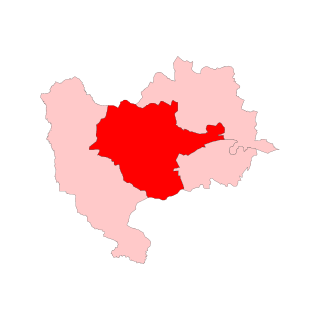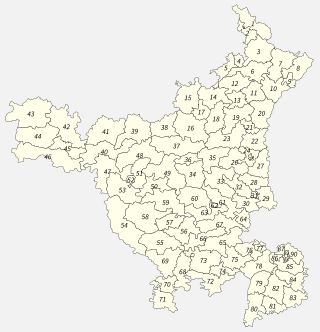
Mahendragarh district is one of the 22 districts of Haryana state in northern India. The district occupies an area of 1,899 km² and has a population of 922,088 (2021census). District have 3 Sub-divisions : Narnaul, Mahendragarh and Kanina
The key political players in Haryana state in northern India are the ruling Bharatiya Janata Party, the Indian National Congress, the Indian National Lok Dal, and smaller parties like the Haryana Janhit Congress and the Bahujan Samaj Party partaking in various state and national level elections in Haryana.
Gohana is a city and a municipal council, near Sonipat city in the Sonipat district of the Indian state of Haryana.
Mahendragarh Lok Sabha constituency was a Lok Sabha (parliamentary) constituency in Haryana state in northern India till 2008.

Haryana, formed on 1 November 1966, is a state in North India. For the administrative purpose, Haryana is divided into 6 revenue divisions which are further divided into 22 districts. For Law and Order maintenance, it is divided into 5 Police Ranges and 4 Police Commissionerates.

Captain Abhimanyu Singh Sindhu is an Indian politician. He was cabinet minister with independent charge of eight departments in the Government of Haryana state in India in the first-ever government led by the Bharatiya Janata Party (BJP) in Haryana.

Gurgaon Lok Sabha constituency is one of the 10 Lok Sabha (parliamentary) constituencies in Haryana state in northern India. This constituency was in existence from 1952-77. It came into existence again in 2008 as a part of the implementation of the recommendations of the Delimitation Commission of India constituted in 2002. This constituency was created by merging five assembly segments of erstwhile Mahendragarh constituency with four assembly segments of erstwhile Faridabad constituency.

Bhiwani–Mahendragarh Lok Sabha constituency is one of the ten Lok Sabha (parliamentary) constituencies in Haryana state in northern India. This constituency came into existence in 2008 as a part of the implementation of the recommendations of the Delimitation Commission of India constituted in 2002.

Maharaja Rao Birender Singh was an Indian politician. He served first as a minister in the state government of Punjab and then as Chief Minister of Haryana, and also served as a minister in Punjab state, Haryana state and the Union cabinet. He also served as the second speaker of Haryana state assembly in 1967. He coined an Indian political vocabulary Aya Ram, Gaya Ram to describe the practice of frequently floor-crossing by legislature.

Tosham Assembly constituency is one of the 90 Vidhan Sabha constituencies in Haryana state in northern India.

Bawani Khera Assembly constituency is one of the 90 Vidhan Sabha constituencies in Haryana state in northern India. This constituency is reserved for the candidates belonging to the Scheduled castes.

Charkhi Dadri Assembly constituency is one of the 90 Vidhan Sabha constituencies in Haryana state in northern India.

Loharu Assembly constituency is one of the 90 Vidhan Sabha constituencies in Haryana state in northern India.

The following outline is provided as an overview of and topical guide to Haryana.

A general election was held on 15 October 2014 to elect 90 members of the Haryana Legislative Assembly. The term of previous assembly elected in 2009 was to expire on 27 October 2014. The results were announced on 19 October. The BJP won the majority in the Assembly. Manohar Lal Khattar was chosen to head the new government.
This is the alphabetical categorised list of statewide, regional and local political families involved in the politics and various elections of Haryana state of India at state and national level.
Dharambir Singh is an Indian politician and a member of Lok Sabha from Bhiwani-Mahendragarh, Haryana. He won the 2014 and 2019 Indian general elections, being a Bharatiya Janata Party member.

Bhiwani Assembly constituency is one of the 90 Vidhan Sabha constituencies in Haryana state in northern India.

Badhra Assembly constituency is one of the 90 Vidhan Sabha constituencies in Haryana state in northern India.

Ateli Assembly constituency is one of the 90 constituencies in the Haryana Legislative Assembly of Haryana a north state of India. Ateli is also part of Bhiwani-Mahendragarh Lok Sabha constituency.





















